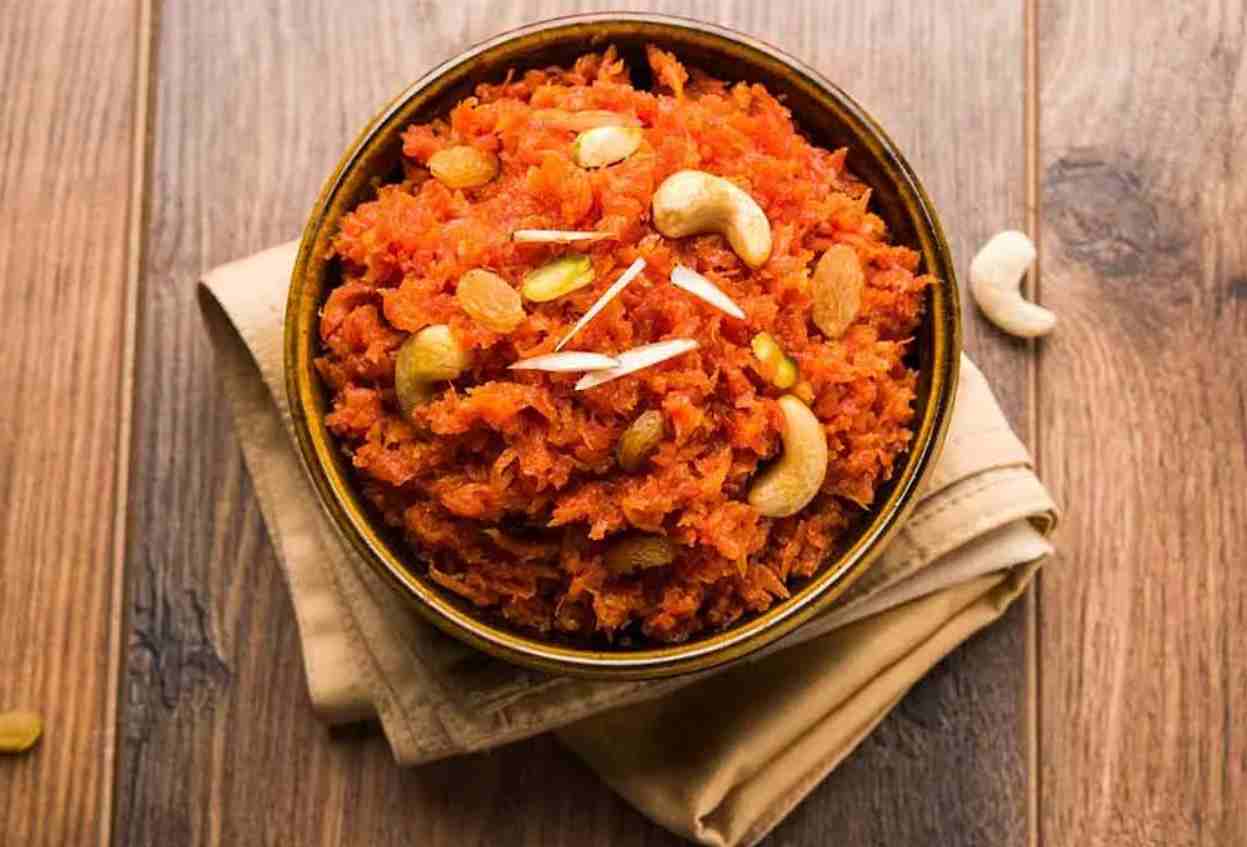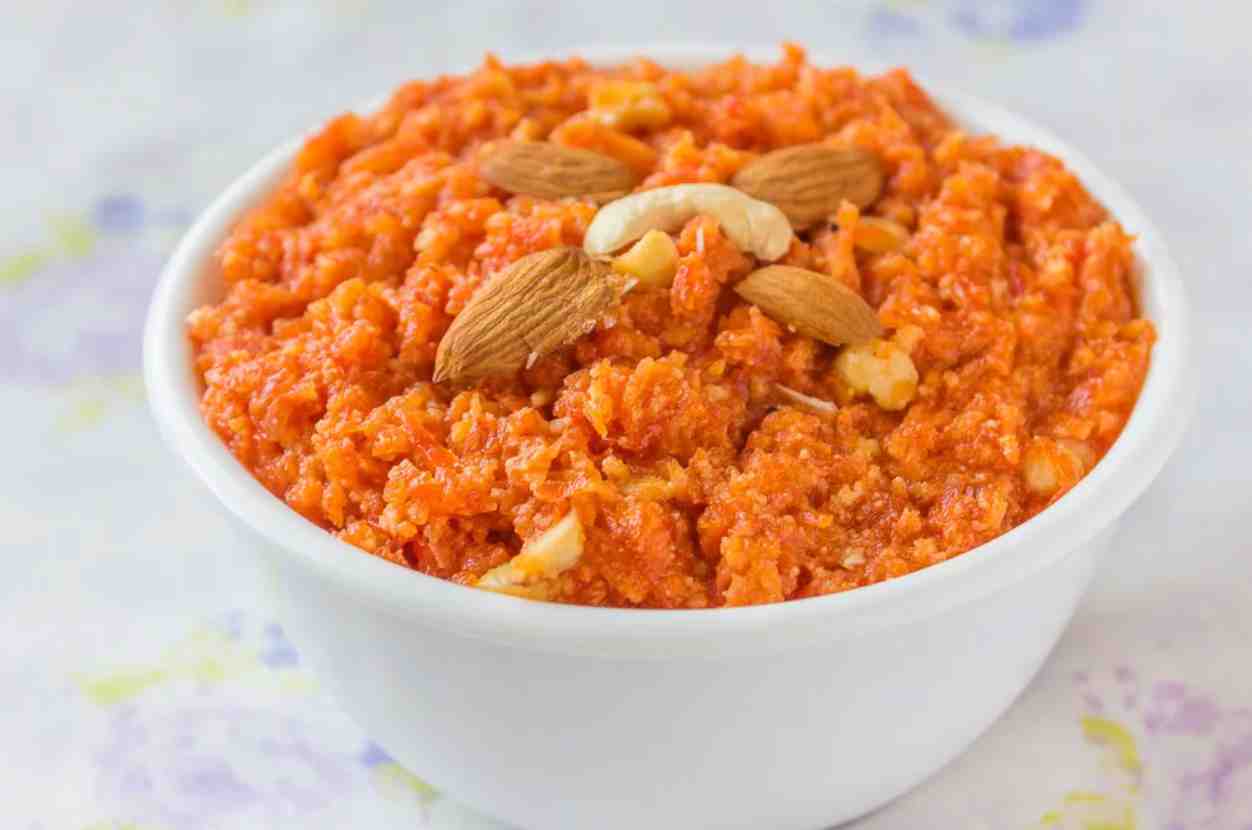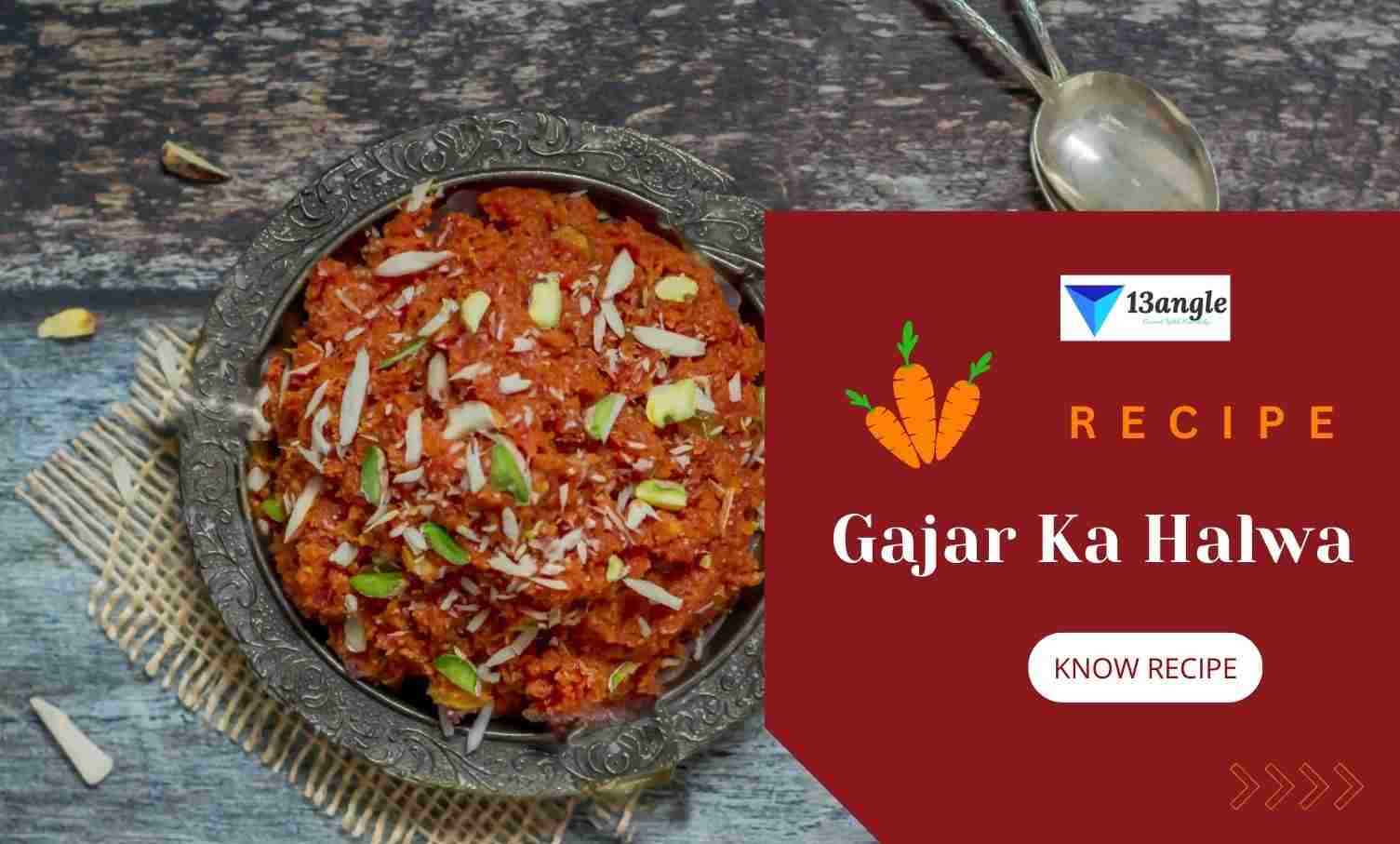- Umang Sagar
- Dessert & Sweets
Soulful Symphony: Gajar Ka Halwa’s Divine Melange of Taste and Tradition

Introduction
Gajar Ka Halwa, a cherished masterpiece of Indian desserts, holds within its golden embrace a timeless tale of flavours and memories. With every spoonful, it transports us to a realm where the simplicity of earthy carrots is transformed into a symphony of indulgence, where the warmth of cardamom and the richness of ghee unite in a dance of sensory delight.
In the heart of this halwa lies the essence of tradition, woven into the fabric of generations past and present. It whispers stories of grandmothers labouring over stoves, gently grating vibrant orange carrots, infusing their homes with an aroma that could coax even the coldest hearts to gather ’round. Gajar Ka Halwa carries with it the weight of countless celebrations, from festivals that paint the streets in hues of joy to intimate family gatherings where its sweet presence is a cherished testament of love.
As we take that first blissful bite, our taste buds awaken to a harmonious blend of sweet and nutty, tender and textured. Its velvety mouthfeel envelops us in comfort, while the delicate crunch of nuts offers a tantalizing contrast. With every morsel, we’re reminded that the most cherished creations often arise from humble beginnings – a simple root vegetable elevated to a culinary masterpiece that transcends time and space.
Gajar Ka Halwa is more than a dessert; it’s a journey through time, a connection to our heritage, and a testament to the artistry of Indian cuisine. It’s a sweet embrace that wraps us in nostalgia, filling our hearts and bellies with a warmth that lingers long after the last spoonful.
History And Origin Of Gajar Ka Halwa

The history and origin of Gajar Ka Halwa (Carrot Halwa) can be traced back to the Indian subcontinent, particularly to North India. This traditional dessert has a rich and storied history that is intertwined with the culinary traditions and cultural heritage of the region.
While the exact historical origins of Gajar Ka Halwa may be difficult to pinpoint, it is believed to have evolved over centuries because of the diverse influences on Indian cuisine. Carrots were introduced to the Indian subcontinent by traders and travellers, and over time, they became an essential ingredient in local dishes.
The preparation of halwa, a sweet dish made by cooking down ingredients like grains, fruits, and vegetables with sugar and ghee, is an ancient tradition in India. The concept of transforming carrots into a sweet and indulgent halwa likely emerged from the ingenuity of Indian cooks and the availability of locally grown carrots.
The dish gained popularity and recognition in North India, especially during the Mughal period (1526-1857). The Mughals, who were known for their opulent lifestyles and luxurious feasts, contributed to the refinement and diversification of Indian cuisine. Gajar Ka Halwa, with its rich and flavourful profile, would have fit perfectly into the Mughal culinary repertoire.
Over time, Gajar Ka Halwa became an integral part of Indian festivals, celebrations, and special occasions. Its popularity spread beyond the North and became a beloved dessert throughout the country. The use of carrots, milk, sugar, and ghee in the halwa reflects the ingredients that were readily available and staples of Indian cuisine.
Today, Gajar Ka Halwa is not only enjoyed in India but is also cherished by people of Indian origin and enthusiasts of Indian cuisine around the world. It has become a symbol of the cultural richness and diversity of Indian sweets.
Recipe: Gajar Ka Halwa (Carrot Halwa)

Gajar Ka Halwa, also known as Carrot Halwa, is a traditional Indian dessert made from grated carrots, milk, sugar, and ghee. It’s a delightful and rich treat enjoyed during festivals, special occasions, or as a sweet indulgence. This detailed recipe will guide you through the process of making delicious Gajar Ka Halwa step by step.
Ingredients:
- 1 kg fresh carrots peeled and grated
- 1 litre full-fat milk
- 1/2 cup ghee (clarified butter)
- 1 cup granulated sugar (adjust to taste)
- 1/2 teaspoon cardamom powder
- 1/4 cup chopped mixed nuts (almonds, cashews, and pistachios)
- A pinch of saffron strands (optional)
- Raisins for garnishing (optional)
Instructions:
- Preparing the Carrots:
- Wash, peel, and grate the carrots using a hand grater or a food processor. The finer the grate, the smoother the halwa will be.
- Squeeze out any excess moisture from the grated carrots using a clean cloth or paper towels.
- Cooking the Carrots:
- In a heavy-bottomed pan or kadai, heat 2 tablespoons of ghee over medium heat.
- Add the grated carrots to the pan and sauté them for about 10-15 minutes. This helps remove the raw taste and enhances the flavour.
- Milk Infusion:
- Pour in the milk and bring the mixture to a boil, then reduce the heat to low-medium.
- Allow the carrots to cook in the milk, stirring occasionally to prevent sticking and burning. This process can take around 60-90 minutes or until the milk reduces significantly, and the carrots become soft and tender.
- You can also add a pinch of saffron strands to the milk while it’s cooking for added flavour and colour.
- Sugar Addition:
- Once the milk has been reduced and the carrots are cooked, add the granulated sugar and mix well.
- Continue to cook, stirring frequently, until the sugar dissolves completely and the mixture thickens further. This might take another 15-20 minutes.
- Ghee and Cardamom:
- Add the remaining ghee to the halwa and mix it in. The ghee adds richness and flavour to the halwa.
- Sprinkle the cardamom powder over the mixture and mix well. The aroma of cardamom enhances the overall taste of the halwa.
- Nutty Indulgence:
- Stir in the chopped nuts, reserving some for garnishing. The nuts add a delightful crunch and texture to the halwa.
- Finishing Touches:
- Continue cooking the halwa, stirring regularly, until it reaches a thick and pudding-like consistency. It should easily come off the sides of the pan.
- Garnishing and Serving:
- Once the halwa is cooked to perfection, turn off the heat and transfer it to a serving dish.
- Garnish with the reserved chopped nuts and some raisins for added sweetness and texture.
- Serving Suggestions:
- Gajar Ka Halwa can be served warm, at room temperature, or even chilled.
- It’s delicious on its own, but you can also serve it with a scoop of vanilla ice cream or a dollop of whipped cream for a decadent twist.
Enjoy your homemade Gajar Ka Halwa, a classic Indian dessert that’s sure to impress your friends and family with its rich flavours and luscious texture!
Top 13 Interesting Facts About Gajar Ka Halwa
Traditional Indian Dessert: Gajar Ka Halwa is a classic and iconic Indian dessert that has been enjoyed for generations, especially during festivals and special occasions.
Historical Origins: The dish is believed to have originated in North India, where it has been prepared and relished for centuries. Its roots can be traced back to the Mughal period.
Carrot Transformation: The dish is a creative way of turning humble carrots into a luxurious and indulgent sweet treat by slow-cooking them with milk, sugar, and ghee.
Flavourful Ingredients: Gajar Ka Halwa is known for its rich, aromatic flavours resulting from the combination of carrots, milk, ghee, sugar, and spices like cardamom.
Cultural Significance: The dessert holds cultural and emotional significance, often being prepared and shared during celebrations like Diwali, weddings, and other festive occasions.
Variations: While the basic recipe remains consistent, there are numerous regional and personal variations of Gajar Ka Halwa, with additional ingredients such as khoya (reduced milk solids) or condensed milk.
Texture and Consistency: Achieving the perfect texture is key; the carrots should be tender, and the halwa should have a creamy yet slightly grainy consistency.
Labor of Love: Making Gajar Ka Halwa requires time and patience, as the carrots are slow-cooked in milk until they absorb the flavours and reduce to a deliciously rich mixture.
Natural Sweetness: The natural sugars present in carrots contribute to the halwa’s sweetness, reducing the need for excessive sugar.
Nutritional Elements: While Gajar Ka Halwa is indulgent, it does offer some nutritional benefits from the carrots and nuts, including vitamins, minerals, and fibre.
Colourful Delight: The dessert’s vibrant orange colour is a visual treat and is often enhanced by the addition of saffron strands.
Serving Styles: Gajar Ka Halwa can be enjoyed warm, at room temperature, or even cold. It can be served on its own, with a scoop of ice cream, or as a topping for desserts like rabri.
Nostalgia and Memories: For many people, Gajar Ka Halwa is not just a dessert but a nostalgic reminder of home-cooked meals and cherished moments with family and friends.



